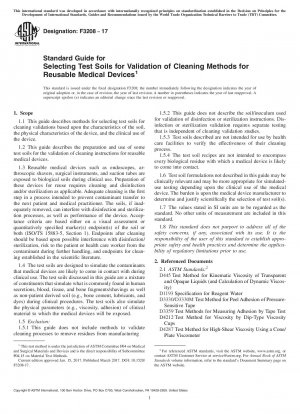ASTM F3208-17
Standard Guide for Selecting Test Soils for Validation of Cleaning Methods for Reusable Medical Devices
- Standard No.
- ASTM F3208-17
- Release Date
- 2017
- Published By
- American Society for Testing and Materials (ASTM)
- Status
- Replace By
- ASTM F3208-18
- Latest
- ASTM F3208-20
- Scope
- 1.1 This guide describes methods for selecting test soils for cleaning validations based upon the characteristics of the soil, the physical characteristics of the device, and the clinical use of the device. 1.2 This guide describes the preparation and use of some test soils for the validation of cleaning instructions for reusable medical devices. 1.3 Reusable medical devices such as endoscopes, arthroscopic shavers, surgical instruments, and suction tubes are exposed to biological soils during clinical use. Preparation of these devices for reuse requires cleaning and disinfection and/or sterilization as applicable. Adequate cleaning is the first step in a process intended to prevent contaminant transfer to the next patient and medical practitioner. The soils, if inadequately removed, can interfere with disinfection and sterilization processes, as well as performance of the device. Acceptance criteria are based either on a visual assessment or quantitatively specified marker(s) endpoint(s) of the soil or both (ISO/TS 15883-5, Section 1). Endpoints after cleaning should be based upon possible interference with disinfection/ sterilization, risk to the patient or health care worker from the contaminant during further handling, and endpoints for cleaning established in the scientific literature. 1.4 The test soils are designed to simulate the contaminants that medical devices are likely to come in contact with during clinical use. The test soils discussed in this guide are a mixture of constituents that simulate what is commonly found in human secretions, blood, tissue, and bone fragments/shavings as well as non-patient derived soil (e.g., bone cement, lubricants, and dyes) during clinical procedures. The test soils also simulate the physical parameters (e.g., viscosity, adhesion) of clinical material to which the medical devices will be exposed. 1.5 Exclusion: 1.5.1 This guide does not include methods to validate cleaning processes to remove residues from manufacturing 1.5.2 This guide does not describe the soil/inoculum used for validation of disinfection or sterilization instructions. Disinfection or sterilization validation requires separate testing that is independent of cleaning validation studies. 1.5.3 Test soils described are not intended for use by health care facilities to verify the effectiveness of their cleaning process. 1.5.4 The test soil recipes are not intended to encompass every biological residue with which a medical device is likely to come into contact. 1.6 Test soil formulations not described in this guide may be clinically relevant and may be more appropriate for simulateduse testing depending upon the clinical use of the medical device. The burden is upon the medical device manufacturer to determine and justify scientifically the selection of test soil(s). 1.7 The values stated in SI units are to be regarded as the standard. No other units of measurement are included in this standard. 1.8 This standard does not purport to address all of the safety concerns, if any, associated with its use. It is the responsibility of the user of this standard to establish appropriate safety and health practices and determine the applicability of regulatory limitations prior to use.
ASTM F3208-17 Referenced Document
- ASTM D1193 Standard Specification for Reagent Water
- ASTM D3330/D3330M Standard Test Method for Peel Adhesion of Pressure-Sensitive Tape*, 2018-10-01 Update
- ASTM D3359 Standard Test Methods for Measuring Adhesion by Tape Test
- ASTM D4212 Standard Test Method for Viscosity by Dip-Type Viscosity Cups
- ASTM D4287 Standard Test Method for High-Shear Viscosity Using a Cone/Plate Viscometer
- ASTM D445 Standard Test Method for Kinematic Viscosity of Transparent and Opaque Liquids (the Calculation of Dynamic Viscosity)
- ASTM D7042 Standard Test Method for Dynamic Viscosity and Density of Liquids by Stabinger Viscometer (and the Calculation of Kinematic Viscosity)*, 2021-11-01 Update
- ASTM D7225 Standard Guide for Blood Cleaning Efficiency of Detergents and Washer-Disinfectors*, 2019-05-01 Update
- ASTM D7867 Standard Test Methods for Measurement of the Rotational Viscosity of Paints, Inks and Related Liquid Materials as a Function of Temperature*, 2020-12-01 Update
- ASTM F2809 Standard Terminology Relating to Medical and Surgical Materials and Devices*, 2024-04-21 Update
- ISO/TS 15883-5 Washer-disinfectors - Part 5: Test soils and methods for demonstrating cleaning efficacy
ASTM F3208-17 history
- 2020 ASTM F3208-20 Standard Guide for Selecting Test Soils for Validation of Cleaning Methods for Reusable Medical Devices
- 2019 ASTM F3208-19 Standard Guide for Selecting Test Soils for Validation of Cleaning Methods for Reusable Medical Devices
- 2018 ASTM F3208-18 Standard Guide for Selecting Test Soils for Validation of Cleaning Methods for Reusable Medical Devices
- 2017 ASTM F3208-17 Standard Guide for Selecting Test Soils for Validation of Cleaning Methods for Reusable Medical Devices
